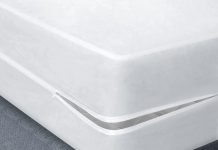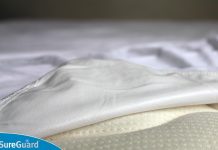So you’ve discovered a tear in your trusty mattress protector, huh? Don’t worry, we’ve got your back (and your mattress). Today, we’re going to explore the ins and outs of fixing a ripped mattress protector. From simple patching methods to DIY sewing solutions, we’ve got all the tips and tricks you need to repair your beloved bed defender. Don’t let a tiny tear disrupt your peaceful slumber any longer – let’s dive in and get your mattress protector back in tip-top shape!
Review contents
Inspect the Damage
When faced with a ripped mattress protector, the first step is to carefully inspect the damage. Take note of the size and location of the rip to determine the best course of action for repair. Additionally, it is important to check for any additional damage that may have occurred, such as fraying edges or multiple tears. By thoroughly examining the extent of the damage, you can better assess the repairability of the mattress protector.
Assess the Repairability
After inspecting the damage, it is essential to assess the repairability of the ripped mattress protector. Consider the size and severity of the rip to determine if it is a minor issue that can be easily fixed or if it requires more extensive repairs. Additionally, evaluate the overall condition of the protector. If it is already worn out or has multiple rips, it may be more practical to replace it rather than attempting to repair it.
Temporary Fixes
If you find yourself in need of a quick fix to temporarily address the rip in your mattress protector, there are several options available. One option is to use fabric tape or adhesive patches specifically designed for repairs. These can be applied over the rip to hold the edges together temporarily. Another temporary fix is to apply a patch with duct tape, ensuring that the rip is fully covered for protection. For those who are handy with a needle and thread, sewing up the rip is also a viable option. Additionally, safety pins can be used for a quick fix, securing the torn edges together until a more permanent solution can be implemented.
Permanent Repairs
For a more durable and long-lasting fix, there are a few permanent repair methods that can be employed. Utilizing a sewing machine with a suitable thread can provide a professional finish and ensure the longevity of the repair. If the rip is substantial, another option is to replace the ripped section with a fabric patch. This can be sewn in place to reinforce the damaged area and prevent further tearing. Alternatively, applying a layer of fabric glue along the edges of the rip can effectively seal the tear. An iron-on mending fabric is another viable option for permanent repairs, providing a secure and seamless finish.
Prevention and Maintenance
To prevent future rips in your mattress protector, investing in a high-quality protector is crucial. Look for protectors made of durable materials that can withstand the wear and tear of daily use. Regularly inspecting and cleaning the protector is also important in maintaining its integrity. By checking for any signs of damage or wear, you can address any issues early on and prevent them from worsening. It is essential to avoid exposing the protector to sharp objects or excessive force, as this can lead to tears and rips. Lastly, always follow the manufacturer’s care instructions to ensure proper maintenance and extend the lifespan of your mattress protector.
Seek Professional Help
In some cases, the damage to a mattress protector may be too severe or complex to repair on your own. If you find yourself in this situation, it is advisable to seek professional help. Contacting the manufacturer is a good first step, as they may offer repair or replacement options for their products. Alternatively, consulting a professional upholstery or mattress repair service can provide the expertise needed to address the damage effectively. These professionals have the knowledge and tools to assess the extent of the damage and provide appropriate solutions.
When to Replace
While repairing a ripped mattress protector can often be a cost-effective solution, there are instances where replacement is the more practical choice. If the rip is too large or extensive to repair, attempting to fix it may not yield satisfactory results. Additionally, if the protector has multiple rips or is showing signs of wear and tear beyond repair, it may be time to invest in a new one. Lastly, if the damage compromises the functionality of the protector, such as rendering it ineffective in protecting against spills or allergies, replacement is recommended to ensure optimal performance.
Frequently Asked Questions
Can I use a mattress protector with a rip?
Using a mattress protector with a rip is not ideal, as it may compromise its effectiveness in protecting your mattress. The rip can allow spills, allergens, or bed bugs to penetrate the protector and potentially damage your mattress. However, in certain cases, a temporary fix may be sufficient to address the rip until a more permanent repair or replacement can be arranged.
How long does a mattress protector typically last?
The lifespan of a mattress protector can vary depending on several factors, including the quality of the protector and the level of use it receives. On average, a good-quality mattress protector can last anywhere from 3 to 5 years. Regular maintenance, such as inspecting and cleaning the protector, can help extend its lifespan and effectiveness.
Can I wash a mattress protector with a rip?
While it is generally safe to wash a mattress protector with a rip, it is important to consider the severity of the rip and the manufacturer’s instructions. If the rip is minor and properly secured, washing the protector should not cause further damage. However, if the rip is extensive or the edges are not properly secured, it is advisable to repair or replace the protector before washing to avoid exacerbating the damage.
How can I prevent future rips in my mattress protector?
Preventing future rips in your mattress protector can be achieved through several measures. Firstly, investing in a high-quality protector made from durable materials can significantly reduce the likelihood of tearing. Regularly inspecting the protector for signs of wear and tear allows for early detection and intervention. Furthermore, avoiding contact with sharp objects or excessive force, and following the manufacturer’s care instructions can help maintain the integrity of the protector and prevent future rips.
































